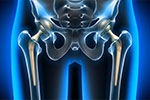Your gluteus maximus is a powerful muscle responsible for helping you perform several everyday tasks. When we cannot complete our daily tasks, we start to worry if we may have pulled a muscle or need medical treatment. We often don't give this muscle a second thought until it becomes painful, or we begin to notice that it's a little tighter than it should be, or our range of motion diminishes.
Learning how to treat a pulled gluteus maximus is a good way to ensure you can stay on your feet. However, these muscle injuries often require medical attention, so educating yourself on how to recognize a pulled gluteus maximus and what you can do to treat it is essential.
What is the Gluteus Maximus?
The gluteus maximus is a large muscle in the lower back and buttocks. It's one of three muscles in the gluteal group, along with the gluteus medius and the gluteus minimus. The gluteus maximus is the largest muscle in the buttocks and the strongest of the three muscles.
It is an important muscle for maintaining balance and stability and protecting the spine from injury. It is responsible for hip extension, abduction, external rotation of the hip, and stabilizing the pelvis. It helps with standing, walking, running, and jumping.
The gluteus maximus is also vital for stabilizing the hip joint during movement. When the gluteus maximus is tight, it can lead to pain, decreased range of motion, and reduced stability. Stretching and strengthening this muscle regularly is essential to prevent injury.
Gluteus Maximus Injuries
With all the work that the gluteus maximus muscles do, they can be prone to injury. Some of the most common gluteus maximus injuries include:
- Sprains: Sprains occur when the ligaments that attach the gluteus maximus to the bone are stretched or torn. Sprains are typically caused by sudden movement, like a sudden twist, or repetitive overuse, like walking or running on uneven surfaces.
- Pulls/Strains: These tend to occur when the muscle is stretched beyond normal limits. When this happens, microtears in the muscle can form, resulting in pain, swelling, and a limited range of motion.
- Tears: Tears can occur when a large amount of force is applied to the muscle, resulting in a complete tear of the muscle fibers.
These injuries can happen to anyone, especially those who don't warm up and cool down properly before and after exercise or other high-intensity activities.
Symptoms of a Gluteus Maximus Injury
Depending on the nature of the injury, those who believe they are suffering from a gluteus maximus injury will experience a range of symptoms, including:
- Pain in the buttocks
- Stiffness in the buttocks/hips
- Visible swelling
- Tenderness in the area
- Discomfort when sitting/standing/bending
The severity of your symptoms depends on the nature of the injury, and can range from very mild to severe.
How to Treat a Pulled Gluteus Maximus
A pulled muscle (also referred to as a strained muscle) is an uncomfortable experience at any severity as it affects the body's ability to function normally. From lying down to sitting and standing, your mobility will be restricted, and pain can become a concern.
Learning how to treat a gluteus maximus pulled muscle is important because it can help you manage the pain and minimize your risk of further damage. Your ability to treat this injury varies depending on the severity, but the good news is that you can do a lot to help.
When dealing with a minor pulled gluteus maximus, you can typically manage the pain at home by applying ice to the affected area, taking a few days off from exercising, and doing some light stretching. A few stretches that you can do for a gluteus pulled maximus muscle include:
- Bridge: Lie on your back with your knees bent and feet flat on the floor. Slowly raise your hips until you feel a stretch in your buttocks. Hold for a few seconds and lower your hips back down. Repeat as needed.
- Hamstring Stretch: While laying flat on your back, lift your affected leg until you feel a stretch in the back of your leg. Hold for 10 seconds and repeat on the other side.
- Seated Hip Rotator Stretch: Sit in a chair and cross one leg over the opposite knee (your foot should rest on the knee). Begin to lean forward until you start to feel a slight stretch in your hip. Hold for 10-15 seconds and release before repeating on the other side.
Of course, you'll want to carefully monitor your pain and soreness to ensure that you're not doing too much too soon. If you don't maintain a regular exercise routine, it’s best to avoid starting any new exercise routine (even stretching) without first consulting your doctor.
When to Seek Medical Treatment for a Strained Gluteus Maximus
Pain, at any level, should never be ignored as it indicates something is wrong. Whether you're a seasoned athlete or have just started to experience discomfort in your glutes, you should always seek a medical opinion before treating yourself.
Treating a Pulled Gluteus Maximus with Help from Dr. Domb
A pulled gluteus maximus can interfere with your daily activities. Without a proper diagnosis and treatment plan, the condition may worsen and your routine can be interrupted.
Dr. Domb is an orthopedic surgeon specializing in sports medicine and is skilled in treating various conditions affecting the hips, knees, and other joints. He's worked with many professional athletes and served many patients in the greater Chicago area, ensuring they can return to their daily lives quickly and safely.
If you think you have a pulled gluteus maximus or are concerned about your symptoms, request your appointment online or call our office at (833)872-4477.





